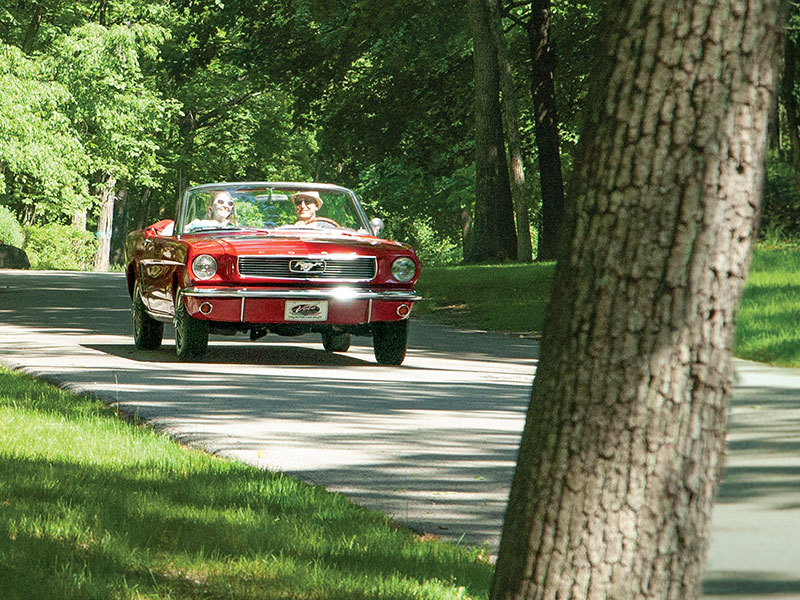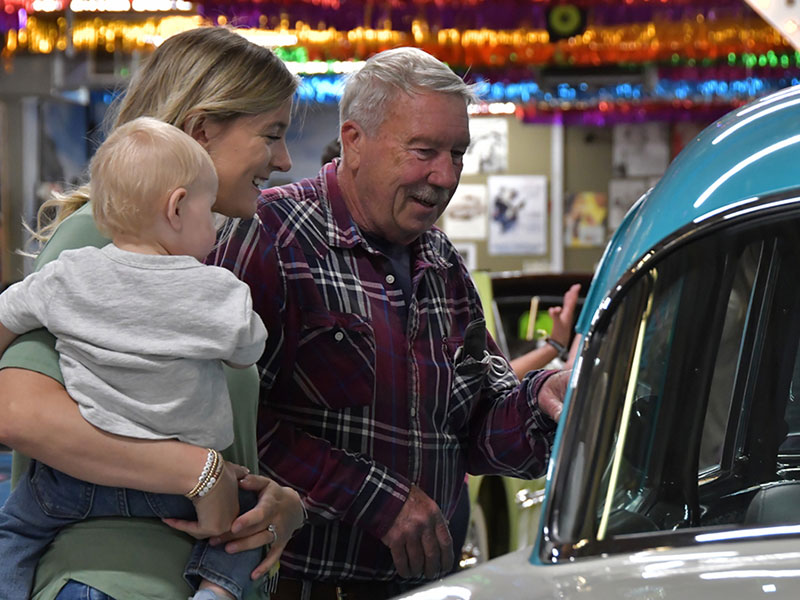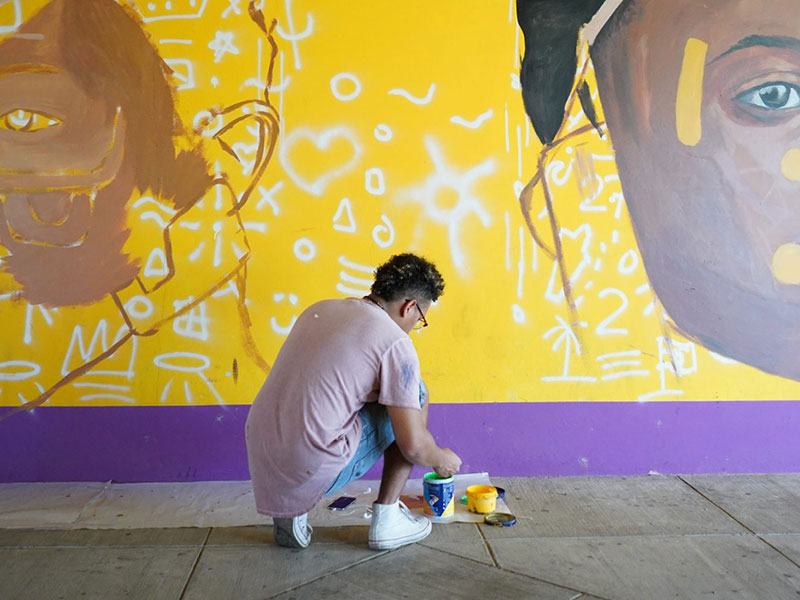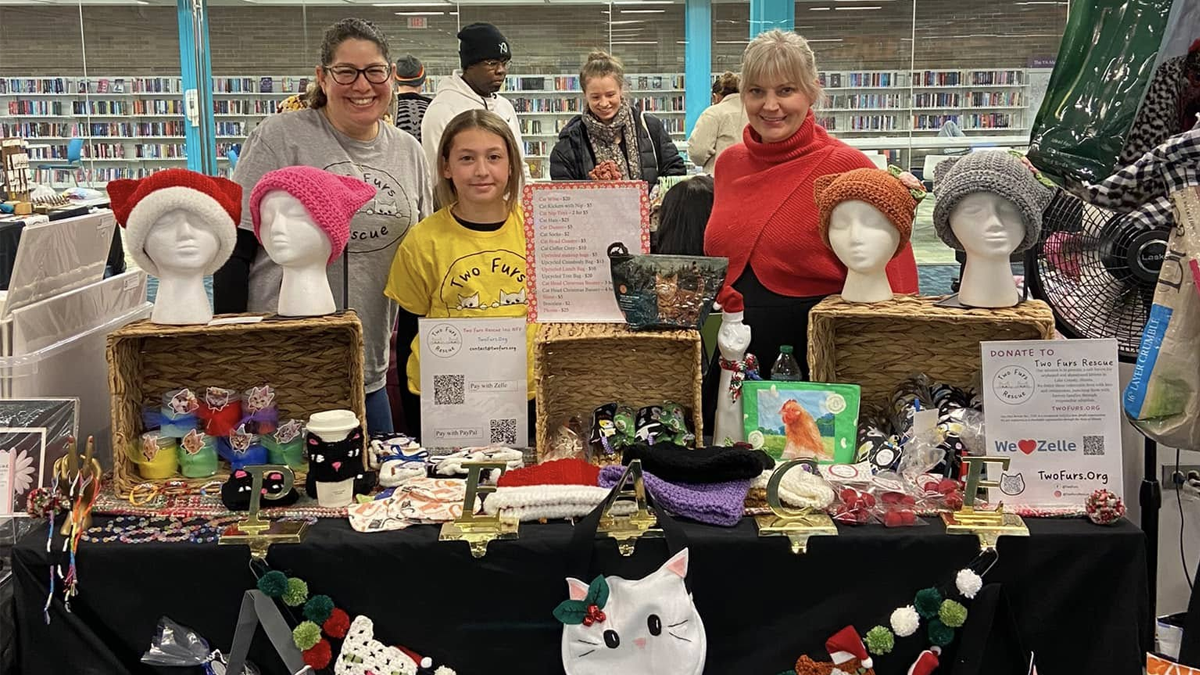Alex Ross Brings "Heroes & Villains" to Dunn Museum’s New Gallery
By: Stephanie Wylie 08/20/2025
Lake County Forest Preserve’s Bess Bower Dunn Museum in Libertyville has opened a new 3,000-square-foot gallery dedicated to major traveling and special exhibitions. To mark the occasion, the museum is showcasing one of the most celebrated artists in comics: Alex Ross.
Ross, widely regarded as the “Norman Rockwell of comics,” is known for redefining the superhero genre through his photorealistic style and deeply human portrayals of iconic characters. His work on projects such as "Marvels," "Kingdom Come" and "Uncle Sam" has cemented his place as one of the most influential illustrators of his generation.
The exhibition, "Heroes & Villains: The Comic Art of Alex Ross," brings together Ross’ larger-than-life portraits of Marvel and DC Comics characters — the first time his renditions of the two universes will be presented together on this scale.
Ross sat down with Visit Lake County to discuss his early inspirations, his traditional art techniques, and what visitors can expect from "Heroes & Villains."
A Conversation with Alex Ross

Visit Lake County (VLC): This isn’t your first time exhibiting at the Dunn Museum. Marvelocity was a huge success a few years ago. What was it about the initial experience that made you want to return and collaborate on something as ambitious as "Heroes & Villains," especially with the new 3,000-square-foot gallery expansion?
Alex Ross: Well, it was delightful to know they had more room to expand in, and to think that I could be the first person that space is very enticing. So I was thrilled with the prospect of working with them again, because it was so easy the first time and so successful. So it’s a wonderful space. And again, the whole thing is a real honor.
VLC: It’s clear from your career that art has always been a part of your life, almost from the very beginning. Your mother even noted that you were drawing at three years old. Can you tell us a bit about those early days in Portland and Lubbock and how they shaped your initial artistic learnings, particularly toward comic books?
Ross: You know, first it was me as a young kid at the age of three, drawing things that are reflecting what I’m seeing on television. And when I got to see comic book characters brought to life on TV that invited a connection to getting the printed material, getting comic books, which, gratefully, my mother started to buy for me. So I was learning to read. So that was a big part of that education for me. And so I could say Spider-Man taught me how to read, but I was obsessed with that as a subject matter, making my own little comic books by taking an 8-by-10 sheet of paper, folding it over and treating it like it was a cover on the one side. I had such a drive for doing that as a child growing up, and that never stopped. So arguably, I could say I’ve been doing this business for 50 years, as opposed to the 37 years I’ve actually been in the business.
VLC: Your work on Marvels and Uncle Sam really solidified your place in the industry. Uncle Sam took a much darker, real-world approach. What motivated you to delve into that side of American history and what was the creative process like for a project so different from the superhero narratives you’re known for?
Ross: There was always the feeling for the comic book marketplace of, can you create something that’s more than just the inside of superhero genre of material, can you create something of relevance? Can you speak to the times you lived in? And some of the comics world has been able to do that and reflect more of that, but always in the confines of superhero iconography. So the fact that superhero iconography is not the only iconography — you can bring in regular pop culture stuff like the image of Uncle Sam, like all fabled characters in history — and work that into a story, which was the drive for making that happen, that is to say I can comment upon my times with things that directly are something people can feel and appreciate immediately, as opposed to wondering how they relate to the world of Superman and Spider-Man.

VLC: You’ve been called the Norman Rockwell of comics, and your photorealistic style is certainly iconic. Many artists today are working digitally, but you famously stick to traditional methods — gouache paints, for example. Can you walk us through your artistic process from concept to finished piece and what draws you to those traditional techniques?
Ross: Well, the beauty about using physical materials is I’m not sitting and looking at a lit screen all day. I like to have hands-on actual material, actual paper and brushes, and arguably, everybody I know working in the art form has made adjustments for using computers more, if only even to scan their work. I still don’t have enough computer skills to know how to scan things. I don’t type. So my wife takes all my emails for me in either dictation or I write it out and leave it for her. So I have tried to remain a firm Luddite in a world that is forcing change, and we’ll see how I win out at the end of the day.
But the joy of working with actual paints is just that — it’s feeling much more almost grounded in nature, if one can consider it such. And all gouache is a water-based media, the same as watercolor, except that each of the paints has opacity already mixed into it. Meaning that when you’re working up an illustration, you can continue to layer and layer it, and you’re building up in a more and more opaque layer, should you want to. You could basically mix white with watercolor paints and effectively get the same outcome, but these are already kind of pre-made that way. And that’s what, as far as an illustration tool, American illustration of the last 100 years, a lot of magazine covers back in the day were created by gouache, because it’s a speedy, quick medium to use. Unlike oil, you don’t have to worry about drying time.
VLC: The concept of these life-size portraits of heroes and villains sounds incredible. Obviously, you mentioned you felt they’d be far more striking at that scale. What do you hope visitors experience when they stand next to these larger-than-life figures?
Ross: Well, I mean, everything about presence has been striving toward realism, but also authentic connection with the source material. So I’m doing less — I am doing a lot of interpretation, but I’m trying to also translate what has been the original artist’s intent as I’ve been raised on it. So the connection to those original visualizations, the original body types, facial types, as much as I can capture that, that’s what I’m endeavoring to try and do.
And so this whole thing about these large paintings becoming even life-size, that’s been a whole effort of trying to put you in the middle of the work. And effectively, it’s an uphill battle, because I’m trying to compete with the Hollywood impression that is so much larger than anything I can outdo. But they’re delivering one thing based upon who they cast at the moment, and that could be a person cast for a part that maybe isn’t fitting for the part, whereas I can just do a one-to-one translation with source material, filter it through realism, through models and exact realistic faces, but being very true to the source.
Bringing Marvel and DC Together

VLC: The Dunn Museum exhibit will be the first time the renditions of DC heroes and villains are shown together with Marvel characters in a formal exhibition of this scale. What was it like bringing two iconic universes together under one roof?
Ross: Well, to me, it’s always been under one roof, because I’ve never been what has often been said for comic collectors, you’re either a Marvel head or a DC head or “Marvel zombie” is the phrase that’s often used. And the thing is, I never saw it that way. Like, it’s the binary choice — that’s very odd. Why would you close off one thing to say, “Oh, I only like this one,” and to me, they’re always intermingled.
In fact, when I was, I think, five or six years old, they did the first official crossover between the two companies, and that still stands to be my favorite comic book of all time. "Superman versus Spider-Man" was extraordinarily well done and beautiful artwork and forever inspirational, so much so that they’re revisiting the same crossover stuff this year.
I’ve always felt like a kinship to both. I could spend time working for either publisher. I feel associated with both characters personally, and for the public, they’ve seen me put an equal amount of effort into both publishers, and I would never want that to change, because it does seem ridiculous to think — I mean, in the weird world we live in, one day, one corporation can own all of it at once.
VLC: Beyond the stunning artwork, the new gallery space significantly expands the museum’s capacity for special exhibitions. From an artist’s perspective, what does having a dedicated larger space like this mean for the presentation of your work and the broader impact of comic book art within the museum setting?
Ross: It’s, for me, it’s obviously a giant ego boost to be presented in such a way, and hopefully it’s an elevation for the art form in terms of people noting that it does have this print life that is the majority of what it had been up until its success with larger media now, but this is the core of what it comes from.
And my hope is there be a greater appreciation extending to the craftsmen and the legacy of the work done up to this point. Because very soon we’ll reach 100 years of comic books existing as an art form, and hopefully I’ll be around for that anniversary.
But, you know, I’ve wanted to make a footprint for how this stuff relates to the world of illustration, particularly how, also, American illustration has evolved in its form. A lot of the avenues for it have closed down, and comic books remain one of the last forms where you have hand-done art of things, where human beings are generating the content. So enjoy it while we got it.
Influences and Artistic Legacy

VLC: Looking back on your incredible career, what do you consider to be the most significant impact your work has had on the comic book industry and on the perception of comic art in the wider art world?
Ross: Hopefully that they take it seriously from multiple levels, that the only thing that matters to the art world generally is what brings in bodies. Will it attract people to come and see it? And that’s a hope that my work is there for you immediately. You can get it in its own state without having to consider a lot of comic art is obviously black and white, has lettering on it, and in some ways, the average person has to forgive all those distractions. And that’s not something you have to worry about with the work I’ve done, particularly in a show like this one where there’s no context of storytelling. It’s just purely figure, not even the competition of a background. So you could take all that in, and then you could see what the assembled work, what impression that makes together.
VLC: Who is your favorite comic book artist?
Ross: Definitely Jack Kirby. Honestly, you could go through the majority of characters here, both heroes and villains, and they were created by that one person. So everything that defines the Marvel Universe is, like, about 80% of it is one person. That’s crazy. And I am very much in love with his art style, so I’m always trying to reflect it back in my published work. I did a "Fantastic Four" graphic novel a couple of years ago that was itself trying to do my realism approximating his pen and ink style. I actually adapted from painted to pen and ink just to sort of show, here’s a closer thing of realizing what his forms might turn to if you try and do a one-to-one interpretation.
I was lucky enough to meet him just a couple years before he passed. I was 22 and going to my very first San Diego Comic-Con, and luckily, I caught him and nobody else was bothering him, and got a photo with him. So I feel very, very blessed that that was one of my experiences.

VLC: You’ve tackled everything from comic book anniversaries to promotional posters for the Academy Awards and even "Yellow Submarine." How do you approach such diverse projects while maintaining your signature style and what’s next on your artistic horizon?
Ross: Well, you don’t really have to fight to maintain your signature style, because you’re just being you. And you figure they came to you for what it is you do. I’m not often doing these projects outside of comic-related material as much, because in a way, there’s a bigger ask of them of what they’re wanting me to deliver. They’ll often provide a laundry list — I’ve done some video game images, and they’ll give me 50 different things to put in a single illustration. And you realize the passion that leads me to create much more ambitious stuff with comics isn’t there for me in those projects, and since my career has been built upon a drive of passion, the projects that I work on are ones that I propose to the publishers. I’ve been fortunate for that. To give myself, over time, to things that I don’t have an industry connection to has been an experiment, a fun diversion, but not where passion lies.
I’m not a gamer, unfortunately. I try to make it look like I’m just as into it as anybody else, but I need a lot of help along the way. And plus, they’ve got their computer renderings that will look much more rendered than anything I can depict. Some of the illustrations I did, "Call of Duty" was one, where they actually gave me 3D representations of each of the figures in the poses matching my layout, and then I painted based upon those images. What was the point?
You had the images already — they could have just rendered out the image. That could have been the layout artist for them. Yeah, but I have more of a purpose with comics, because I still feel like comics is the little trade that could.
Closing Thoughts and the Message of "Heroes & Villains"

VLC: Lastly, for visitors who might be seeing your work for the first time at "Heroes & Villains," what message do you hope they take away from the exhibition?
Ross: I'm sure there’s some words about heroism being inspiring or something like that. I think that maybe when people see a lot of figures I’ve done, they see a physicality to the work that maybe feels, I don’t know, you should call it grounded, but that is often what I get thrown back at me — it feels like people, human beings, that are viewing these forms and certainly idealized, but in their own way, carrying a weight that we carry as people.
And I hope it’s a connection that people feel for, if not introducing them to certain characters that they don’t know, but also just appreciation for the iconography that I tried to sell as passionately as I could, to say I love each of these designs. If I didn’t, I wouldn’t have included the characters that are in this exhibit. And I’m trying to tell you in paint strokes why you should care, why you should find that to be aesthetically pleasing and I’m hoping you get convinced at the end of the journey.
For more information about Alex Ross, click here. To learn more about the Bess Bower Dunn Museum, continue here. To find out about all of the events going on at the forest preserves and across the county, click here.


 WINTER OUTDOOR GUIDE
WINTER OUTDOOR GUIDE ROAD TRIPS
ROAD TRIPS Volo Museum
Volo Museum Family-Friendly Dining
Family-Friendly Dining Breakfast/Brunch
Breakfast/Brunch Lakeside Dining
Lakeside Dining MainStreet Libertyville
MainStreet Libertyville Historic Downtown Long Grove
Historic Downtown Long Grove Downtown Highland Park
Downtown Highland Park Great Wolf Lodge Illinois
Great Wolf Lodge Illinois Lincolnshire Marriott Resort
Lincolnshire Marriott Resort Hyatt Deerfield
Hyatt Deerfield Visitors Guide
Visitors Guide Special Offers
Special Offers Accommodations
Accommodations Weddings
Weddings Group Tours
Group Tours Military Reunions
Military Reunions Community Partners
Community Partners Partner Directory
Partner Directory Become a Partner
Become a Partner

























